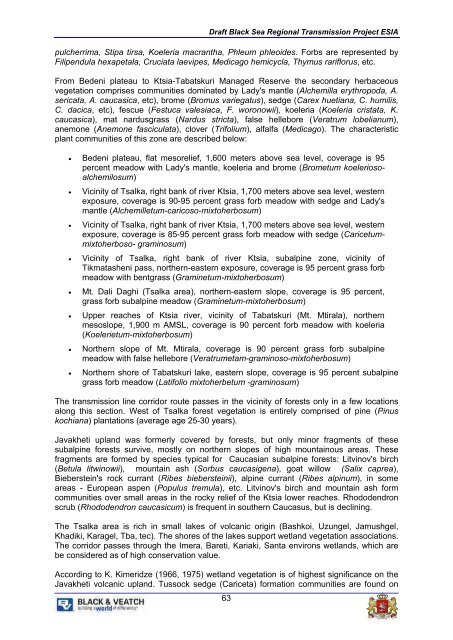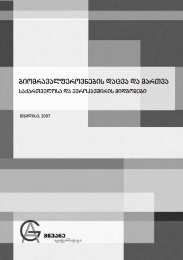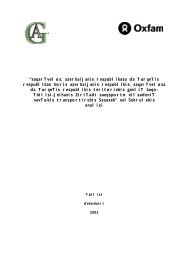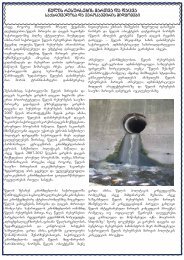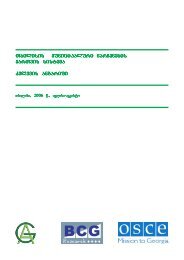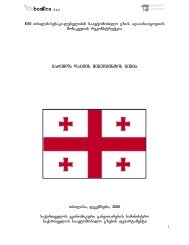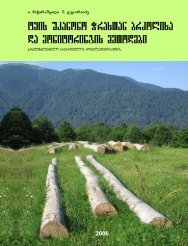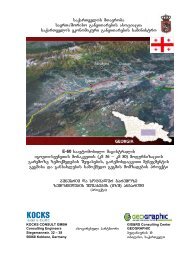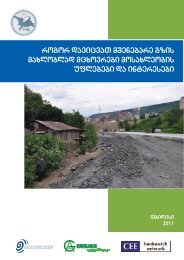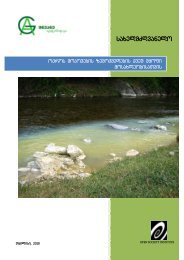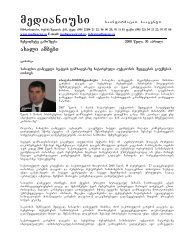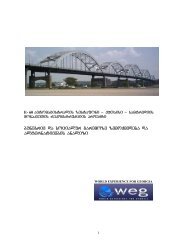Part I
Part I
Part I
You also want an ePaper? Increase the reach of your titles
YUMPU automatically turns print PDFs into web optimized ePapers that Google loves.
Draft Black Sea Regional Transmission Project ESIA<br />
pulcherrima, Stipa tirsa, Koeleria macrantha, Phleum phleoides. Forbs are represented by<br />
Filipendula hexapetala, Cruciata laevipes, Medicago hemicycla, Thymus rariflorus, etc.<br />
From Bedeni plateau to Ktsia-Tabatskuri Managed Reserve the secondary herbaceous<br />
vegetation comprises communities dominated by Lady's mantle (Alchemilla erythropoda, A.<br />
sericata, A. caucasica, etc), brome (Bromus variegatus), sedge (Carex huetiana, C. humilis,<br />
C. dacica, etc), fescue (Festuca valesiaca, F. woronowii), koeleria (Koeleria cristata, K.<br />
caucasica), mat nardusgrass (Nardus stricta), false hellebore (Veratrum lobelianum),<br />
anemone (Anemone fasciculata), clover (Trifolium), alfalfa (Medicago). The characteristic<br />
plant communities of this zone are described below:<br />
Bedeni plateau, flat mesorelief, 1,600 meters above sea level, coverage is 95<br />
percent meadow with Lady's mantle, koeleria and brome (Brometum koeleriosoalchemilosum)<br />
<br />
<br />
<br />
<br />
<br />
<br />
<br />
Vicinity of Tsalka, right bank of river Ktsia, 1,700 meters above sea level, western<br />
exposure, coverage is 90-95 percent grass forb meadow with sedge and Lady's<br />
mantle (Alchemilletum-caricoso-mixtoherbosum)<br />
Vicinity of Tsalka, right bank of river Ktsia, 1,700 meters above sea level, western<br />
exposure, coverage is 85-95 percent grass forb meadow with sedge (Caricetummixtoherboso-<br />
graminosum)<br />
Vicinity of Tsalka, right bank of river Ktsia, subalpine zone, vicinity of<br />
Tikmatasheni pass, northern-eastern exposure, coverage is 95 percent grass forb<br />
meadow with bentgrass (Graminetum-mixtoherbosum)<br />
Mt. Dali Daghi (Tsalka area), northern-eastern slope, coverage is 95 percent,<br />
grass forb subalpine meadow (Graminetum-mixtoherbosum)<br />
Upper reaches of Ktsia river, vicinity of Tabatskuri (Mt. Mtirala), northern<br />
mesoslope, 1,900 m AMSL, coverage is 90 percent forb meadow with koeleria<br />
(Koelerietum-mixtoherbosum)<br />
Northern slope of Mt. Mtirala, coverage is 90 percent grass forb subalpine<br />
meadow with false hellebore (Veratrumetam-graminoso-mixtoherbosum)<br />
Northern shore of Tabatskuri lake, eastern slope, coverage is 95 percent subalpine<br />
grass forb meadow (Latifolio mixtoherbetum -graminosum)<br />
The transmission line corridor route passes in the vicinity of forests only in a few locations<br />
along this section. West of Tsalka forest vegetation is entirely comprised of pine (Pinus<br />
kochiana) plantations (average age 25-30 years).<br />
Javakheti upland was formerly covered by forests, but only minor fragments of these<br />
subalpine forests survive, mostly on northern slopes of high mountainous areas. These<br />
fragments are formed by species typical for Caucasian subalpine forests: Litvinov's birch<br />
(Betula litwinowii), mountain ash (Sorbus caucasigena), goat willow (Salix caprea),<br />
Bieberstein's rock currant (Ribes biebersteinii), alpine currant (Ribes alpinum), in some<br />
areas - European aspen (Populus tremula), etc. Litvinov's birch and mountain ash form<br />
communities over small areas in the rocky relief of the Ktsia lower reaches. Rhododendron<br />
scrub (Rhododendron caucasicum) is frequent in southern Caucasus, but is declining.<br />
The Tsalka area is rich in small lakes of volcanic origin (Bashkoi, Uzungel, Jamushgel,<br />
Khadiki, Karagel, Tba, tec). The shores of the lakes support wetland vegetation associations.<br />
The corridor passes through the Imera, Bareti, Kariaki, Santa environs wetlands, which are<br />
be considered as of high conservation value.<br />
According to K. Kimeridze (1966, 1975) wetland vegetation is of highest significance on the<br />
Javakheti volcanic upland. Tussock sedge (Cariceta) formation communities are found on<br />
63


